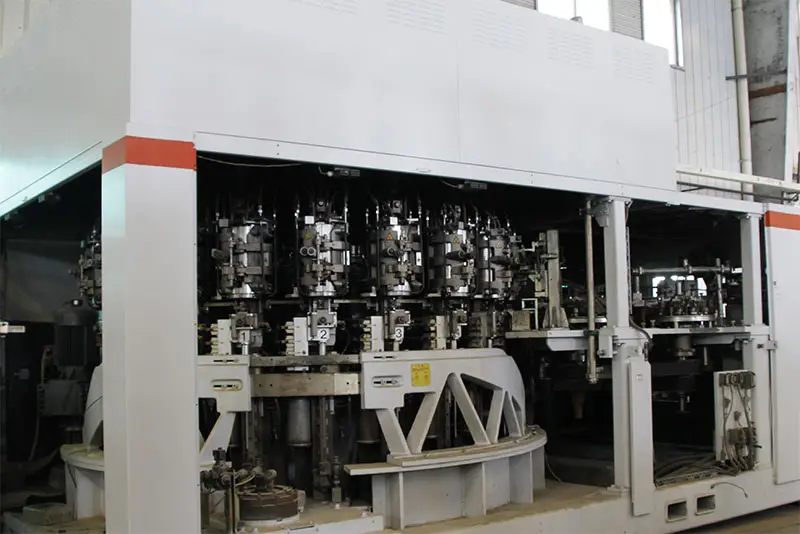With the development of the liquid food market, the application of PET bottles in industries such as beverages and dairy products is becoming increasingly widespread, creating a good opportunity for the development of PET packaging machinery.
Currently, there are mainly two types of blow molding machines in the market: rotary and linear. They basically use a two-step production process: the preform machine produces bottle preforms, and the blow molding machine goes through processes like preform handling, heating, stretching, pre-blowing, high-pressure blowing (or additional cooling), exhaust, and bottle retrieval to produce finished PET bottles.
Rotary blow molding machines have high output, good versatility, and stability. They can produce different types and sizes of bottles on the same machine, but they are more expensive and suitable for customers with higher production volumes. On the other hand, linear blow molding machines have moderate output, lower prices, and average compatibility. Due to the impact of the drive chain and other structures, bottles with significant volume variations require different models of linear machines, making them suitable for customers with medium to low production volumes.
Now, let’s analyze and compare rotary and linear blow molding machines.
1. Layout:
The layout of blow molding machines varies significantly due to structural differences. Rotary blow molding machines consist of preform handling, heating, main machine, and electrical components. Each part can be separated for easy disassembly and transportation, suitable for continuous and high-speed production with a blowing direction of positive blowing. Linear blow molding machines have various layout styles. One type has the main machine and heating centralized on one machine base for intermittent production with a blowing direction of inverse blowing.
Another type has the main machine and heating separated for continuous production with a blowing direction of positive blowing, which is a key factor in increasing production.
2. Production Efficiency:
There is a certain gap in production efficiency between the two types of blow molding machines. Rotary blow molding machines have the advantage of having a high number of mold cavities, high output, and ease of continuous production, operation, and maintenance.
For example, machines like vikeind can produce 1500 to 1800 bottles per hour per mold cavity, with 6 to 24 cavities and even designs with over 30 cavities.
Sidel blow molding machines can reach a production rate of 1800 to 2000 bottles per hour per mold. On the other hand, domestically produced linear blow molding machines mostly have a production rate of around 800 to 1200 bottles per hour per mold cavity with 4 to 10 cavities, though some manufacturers can design machines with 12 to 16 cavities.
Foreign machines like Sipa use fully electric linear machines with a production rate of over 1500 bottles per hour per mold. Their unique structure and layout are worth studying and learning from.
3. Transmission System:
Linear machines mainly use servo motors for driving, with the heating chain in intermittent motion. Some use pneumatic cylinders to drive the heating chain, causing issues like clamping or interference with the chain and workpiece precision during operation. Fully electric linear machines abroad use servo motors or cam mechanisms for driving, enabling one mold cycle per rotation, allowing for flexible production rate adjustments. The vibration caused by mold opening and closing is much less compared to hydraulic or pneumatic drives, making this locking mechanism an ideal choice for linear machines.
4. Mold Structure:
Due to the different machine structures, there are significant differences in mold frame structures. Rotary machine mold frames consist of moving and fixed frames, a middle mold sleeve, and molds. The moving and fixed frames can open and close at a certain angle around an axis, with each set typically having one mold cavity, although some foreign manufacturers can design machines with 2 to 3 cavities. To reduce rotational inertia, the mold frame must be lightweight yet strong.
Linear machine mold frames mostly consist of two moving frames and two fixed frames, with the moving frames moving at equidistant intervals along guide columns or rails. They can accommodate 2 to 10 mold cavities, with materials typically being ductile iron or carbon steel welding.
5. Mold Locking Mechanism:
The mold locking mechanism is crucial to prevent mold expansion during the blow molding process, as the extent of expansion directly affects the quality of the bottles. Rotary machines mainly use pin or rotary locking mechanisms controlled by guide rails to reduce impact, vibration, and noise during operation. Linear machines primarily use hydraulic or pneumatic cylinder drives, which, due to the large mass of the mold frame driven by the connecting rod, can cause equipment vibration during operation, especially during mold opening and closing. Fully electric linear machines abroad use servo motors or cam mechanisms for driving, enabling one mold cycle per rotation, allowing for flexible production rate adjustments. The vibration caused by mold opening and closing is much less compared to hydraulic or pneumatic drives, making this locking mechanism an ideal choice for linear machines.
In conclusion
Whether it is a rotary bottle blowing machine or a linear bottle blowing machine, you have to choose according to your actual needs. Vikeind bottle blowing machine manufacturer provides customized solutions according to your needs, reducing your costs under the same output. to the minimum, providing strong support for your business growth.

